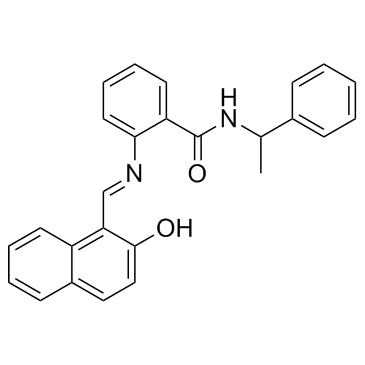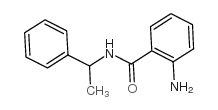410536-97-9
| Name | Sirtinol,2-[[(2-Hydroxy-1-naphthalenyl)methylene]amino]-N-(1-phenylethyl)benzamide |
|---|---|
| Synonyms |
2-{[(E)-(2-hydroxynaphthalen-1-yl)methylidene]amino}-N-(1-phenylethyl)benzamide
2-{[(E)-(2-Hydroxy-1-naphthyl)methylene]amino}-N-(1-phenylethyl)benzamide sir two inhibitor naphthol sirtinol 2-{(E)-[(2-Hydroxy-1-naphthyl)methylene]amino}-N-(1-phenylethyl)benzamide |
| Description | Sirtinol is a sirtuin inhibitor, with IC50s of 48 μM, 57.7 μM and 131 μM for ySir2, hSIRT2 and hSIRT2, respectively. |
|---|---|
| Related Catalog | |
| Target |
ySir2:48 μM (IC50) hSIRT2:57.7 μM (IC50) hSIRT1:131 μM (IC50) |
| In Vitro | Sirtinol reduces the growth of MCF-7 cells in a concentration- and time-dependent manner. The IC50 values of sirtinol are 48.6 μM and 43.5 μM after 24 and 48 h of treatment, respectively. Sirtinol significantly decreases SIRT1 expression and increases the acetylated p53 level[1]. Sirtinol attenuates the proliferation and induces apoptosis of nonsmall cell lung cancer (NSCLC) H1299 cells and causes the significantly increased level of FoxO3a, a proapoptotic transcription factor targeted by Sirt1[2]. |
| In Vivo | Sirtinol has anti-inflammatory effects through direct inhibition of HNE activity and attenuates HNE-induced and LPS-mediated tissue or organ injury[3]. |
| Cell Assay | Sirtinol is dissolved in 100% DMSO at concentration of 10 mM and stored at −20°C until use. The cell proliferation of H1299 cells is determined by trypan blue dye exclusion assay. Human nonsmall cell lung cancer (NSCLC) cells are seeded in 12-well plates and treated with indicated concentrations of sirtinol (0, 10, 20, and 50 μM) for 24 h and 48 h, respectively. After incubation, the cells are stained by 0.2% trypan blue and counted by Countess[2]. |
| Animal Admin | Mice: 30 male mice (20–25 g, 7–8 weeks old) are used in this model. Briefly, mice are randomly divided into five groups; then mice are intraperitoneally injected with 50 μL DMSO (vehicle group) or sirtinol (2.5 or 5.0 mg/kg body weight). After 1 h, paw inflammation is induced . The thickness of the paw is measured before and after HNE or saline injection[3]. |
| References |
| Density | 1.2±0.1 g/cm3 |
|---|---|
| Boiling Point | 659.2±50.0 °C at 760 mmHg |
| Melting Point | 119-120℃ |
| Molecular Formula | C26H22N2O2 |
| Molecular Weight | 394.465 |
| Flash Point | 352.5±30.1 °C |
| Exact Mass | 394.168121 |
| PSA | 61.69000 |
| LogP | 6.20 |
| Vapour Pressure | 0.0±2.1 mmHg at 25°C |
| Index of Refraction | 1.623 |
| Storage condition | −20°C |
| Water Solubility | Soluble in water, DMSO and methanol |
| WGK Germany | 3 |
|---|---|
| HS Code | 2925290090 |
|
~96% 
410536-97-9 |
| Literature: US2009/137681 A1, ; Page/Page column 30; 32-33 ; US 20090137681 A1 |
| Precursor 2 | |
|---|---|
| DownStream 0 | |
| HS Code | 2925290090 |
|---|---|
| Summary | 2925290090 other imines and their derivatives; salts thereof。Supervision conditions:None。VAT:17.0%。Tax rebate rate:9.0%。MFN tariff:6.5%。General tariff:30.0% |

